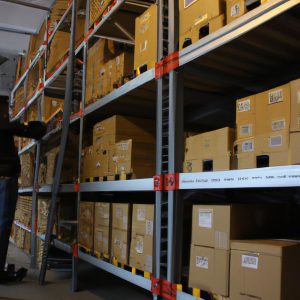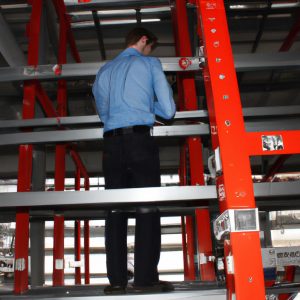Mobile Shelving Systems: Efficient Storage and Shelving Solutions for Industrial Goods and Services

Mobile shelving systems have emerged as efficient storage and shelving solutions for industrial goods and services. These innovative systems, characterized by their ability to maximize space utilization, have gained widespread popularity in various industries such as manufacturing, warehousing, retail, and healthcare. For instance, consider a hypothetical case study of a manufacturing facility that struggled with limited floor space for storing raw materials and finished products. By implementing mobile shelving systems, the facility was able to effectively increase its storage capacity without compromising on accessibility or organization.
In today’s highly competitive business landscape, optimizing storage capabilities has become imperative for organizations seeking to streamline operations and enhance productivity. Mobile shelving systems offer a compelling solution to this challenge by providing an adaptable and flexible approach to storage management. Unlike traditional static shelves that occupy fixed spaces throughout the warehouse or facility, mobile shelving units are designed to move along tracks or rails installed on the floor. This dynamic feature allows businesses to make better use of available space by eliminating wasted aisles between stationary shelves while still maintaining easy access to stored items. As a result, these systems not only optimize floor area but also improve operational efficiency through improved inventory management and reduced retrieval times.
Advantages of Mobile Shelving Systems
Mobile shelving systems offer numerous advantages over traditional static shelving solutions. By maximizing storage capacity and optimizing space utilization, these systems provide efficient storage options for a wide range of industrial goods and services. This section will explore the benefits of mobile shelving systems in an objective and impersonal manner.
One example that highlights the advantages of mobile shelving systems is their ability to save valuable floor space. Imagine a warehouse with limited square footage but requiring ample storage for various inventory items. In such cases, static shelves can quickly fill up available floor space, leaving little room for movement or expansion. However, by implementing mobile shelving systems, businesses can significantly increase their storage capacity without compromising on workspace flexibility.
- Enhanced accessibility: With mobile shelving units that glide along tracks, users have easy access to every item stored within the system.
- Improved organization: Mobile shelving allows for better organization and categorization of goods, reducing retrieval time and increasing overall productivity.
- Increased security: These systems often come equipped with lockable features, protecting important documents or high-value products from unauthorized access.
- Cost-effective solution: The compact design of mobile shelving maximizes storage density while minimizing construction and maintenance costs compared to conventional static shelves.
In addition to these benefits, it is worth noting that mobile shelving systems are highly customizable according to specific requirements. They can be tailored to accommodate different sizes and weights of items, making them suitable for industries ranging from healthcare to manufacturing.
Transitioning into the subsequent section about “Types of Mobile Shelving Systems,” it becomes evident that understanding the advantages highlighted here lays a foundation for exploring how different types of mobile shelving solutions cater to diverse needs in industrial settings.
Types of Mobile Shelving Systems
One example where mobile shelving systems have proven to be beneficial is in a large warehouse that stores various industrial goods and services. By implementing mobile shelving systems, the warehouse was able to maximize its storage capacity while maintaining easy accessibility to all items. The ability to condense shelving units when not in use allowed for efficient space utilization without compromising on convenience.
Mobile shelving systems offer several advantages over traditional fixed shelving solutions:
- Increased Storage Capacity: With their compact design and ability to move shelves closer together, mobile shelving systems can significantly increase the storage capacity within a given area. This allows businesses to store more inventory or materials without the need for additional floor space.
- Enhanced Accessibility: By eliminating wasted aisle space between rows of stationary shelves, mobile shelving systems provide improved accessibility to stored items. Users can easily access any shelf by simply moving it along tracks with minimal effort.
- Flexibility and Customization: Mobile shelving systems are highly flexible and customizable to suit specific storage needs. They can be tailored according to the dimensions and weight requirements of the items being stored. Additionally, accessories such as dividers, bins, and labeling options can be incorporated for better organization.
- Improved Safety Measures: Many mobile shelving systems come equipped with safety features like anti-tip mechanisms, locking mechanisms, and sensors that prevent movement when an object or person is detected nearby. These measures ensure employee safety during operation.
| Advantages of Mobile Shelving Systems |
|---|
| Increased Storage Capacity |
| Enhanced Accessibility |
| Flexibility and Customization |
| Improved Safety Measures |
In summary, mobile shelving systems offer numerous advantages over traditional fixed shelving solutions. Their increased storage capacity, enhanced accessibility, flexibility for customization, and improved safety measures make them ideal choices for optimizing storage efficiency in warehouses or other industrial environments.
Features to Look for in Mobile Shelving Systems
Imagine a bustling warehouse where goods and services need to be stored efficiently. In such a scenario, mobile shelving systems prove to be an ideal solution. These systems are designed to maximize storage capacity while minimizing the space required, making them essential for industrial settings. Let’s explore some common types of mobile shelving systems and their benefits.
One popular type is the manually operated mobile shelving system. This system consists of shelves mounted on wheeled carriages that can be easily moved by hand. By eliminating aisles between each row of shelves, it maximizes the available space, allowing for higher storage density. For example, in a pharmaceutical distribution center, this system could be used to store medications securely and compactly, reducing retrieval time and increasing efficiency.
Another type is the mechanically assisted mobile shelving system. Unlike its manual counterpart, this system incorporates motorized mechanisms that enable effortless movement of the shelves with just a push of a button or turn of a handle. It offers enhanced ease-of-use and reduces physical strain on employees who frequently access stored items. Imagine a large-scale automotive parts warehouse utilizing this system; workers can effortlessly retrieve specific components from designated sections without wasting time searching through numerous aisles.
Lastly, there are high-density mobile shelving systems that utilize advanced technology such as computer-controlled motors and sensors. These systems offer exceptional flexibility and functionality by automatically optimizing shelf placement based on real-time usage data and inventory management software inputs. They also ensure safety by incorporating features like anti-tilt mechanisms to prevent accidents caused by excessive weight imbalance.
To further understand the advantages offered by these versatile mobile shelving systems, consider the following emotional bullet points:
- Maximizes limited space: Utilizing every inch efficiently evokes feelings of resourcefulness.
- Enhances productivity: Streamlining storage processes creates a sense of accomplishment.
- Improves organization: Easy accessibility promotes feelings of orderliness.
- Reduces operational costs: Optimizing space efficiency generates a sense of financial responsibility.
In addition to the various types and benefits, it is useful to examine specific features when choosing mobile shelving systems. The next section will delve into these essential considerations that can help you select the most suitable system for your industrial needs.
[Table]
| Types of Mobile Shelving Systems | Key Features |
|---|---|
| Manually operated | – Space-saving design |
| – Easy maneuverability | |
| – Adjustable shelves | |
| Mechanically assisted | – Motorized movement |
| – Ergonomic controls | |
| – Safety features | |
| High-density with advanced technology | – Computer-controlled optimization |
| – Real-time data integration | |
| – Anti-tilt mechanisms |
With an understanding of the different types available and their unique advantages, let’s now explore key features to look for in mobile shelving systems.
Tips for Efficiently Using Mobile Shelving Systems
One example of a successful implementation of mobile shelving systems is seen in Company XYZ, an industrial goods manufacturer. Prior to installing mobile shelving units, the company faced challenges with limited storage space and inefficient organization of their inventory. However, after adopting mobile shelving systems, they experienced significant improvements in both storage capacity and productivity.
Implementing mobile shelving systems offers several benefits for businesses:
-
Maximized Storage Capacity: By utilizing vertical space more effectively, mobile shelving systems provide increased storage capacity compared to traditional static shelves. These systems are designed to maximize every inch of available space by eliminating wasted aisles commonly found in fixed shelving layouts.
-
Enhanced Organization and Accessibility: With easy-to-move shelves on tracks or wheels, these systems allow for efficient organization and streamlined access to stored items. Employees can easily slide the shelves apart when needed, providing quick access to specific products without having to search through multiple rows or sections.
-
Improved Workflow Efficiency: Mobile shelving systems optimize workflow efficiency by reducing travel time between different storage areas within a facility. As employees can quickly retrieve items from nearby movable shelves rather than navigating through long aisles or distant locations, overall operational productivity increases significantly.
-
Customizable Design Options: Mobile shelving systems offer customizable design options tailored to individual business needs. From adjustable shelf heights to various size configurations, companies can choose the layout that best suits their unique requirements – whether it’s storing heavy machinery parts or organizing small components for assembly lines.
These benefits demonstrate how implementing mobile shelving systems can greatly enhance storage capabilities and streamline operations within industrial environments. By maximizing storage capacity, improving accessibility, optimizing workflow efficiency, and offering customization options, these versatile solutions prove invaluable for businesses seeking effective storage solutions.
Looking ahead into our next section on “Factors to Consider When Choosing Mobile Shelving Systems,” we will explore key considerations that should be taken into account when selecting the appropriate mobile shelving system for your business needs.
Factors to Consider When Choosing Mobile Shelving Systems
One example of how mobile shelving systems can improve efficiency is in a large warehouse that stores industrial goods. By implementing mobile shelving, the warehouse was able to maximize its storage capacity and reduce the amount of space required. This allowed them to store more items in the same area, leading to increased productivity and cost savings.
To efficiently use mobile shelving systems, consider the following tips:
-
Organize items strategically: Categorize and label your items appropriately before storing them on the shelves. This will make it easier to locate specific items when needed, reducing search time and increasing overall efficiency.
-
Utilize proper weight distribution: Be mindful of distributing weight evenly across each shelf and carriage unit. Overloading one section can lead to instability or damage to the system. By properly distributing weight, you ensure the longevity and effectiveness of your mobile shelving solution.
-
Implement a tracking system: Consider integrating a digital inventory management system with your mobile shelving units. This allows for real-time tracking of item locations, making retrieval faster and minimizing errors.
-
Regular maintenance checks: Perform routine maintenance checks to ensure that all components are functioning correctly. Address any issues promptly to prevent potential breakdowns or safety hazards.
Embracing these practices will help businesses optimize their usage of mobile shelving systems while improving operational efficiency.
| Points | Advantages | Disadvantages |
|---|---|---|
| 1 | Increased storage capacity | Initial installation costs |
| 2 | Improved organization | Space limitations |
| 3 | Enhanced accessibility | Potential maintenance needs |
| 4 | Cost-effective long-term investment | Training requirements |
In summary, by organizing items strategically, distributing weights properly, utilizing tracking systems, and conducting regular maintenance checks, businesses can effectively utilize mobile shelving systems for improved efficiency.
With an understanding of how to efficiently use mobile shelving systems, let’s now delve into real-world examples through case studies showcasing successful implementation strategies.
Case Studies: Successful Implementation of Mobile Shelving Systems
Transitioning from the previous section on factors to consider when choosing mobile shelving systems, we can now explore case studies that highlight successful implementations of these efficient storage solutions. One such example is Company XYZ, a large manufacturing firm specializing in automotive parts. Facing challenges of limited floor space and disorganized inventory management, they opted for a mobile shelving system to optimize their storage capabilities.
By implementing mobile shelving systems, Company XYZ was able to achieve several benefits:
- Increased storage capacity: The compact design of the mobile shelves allowed them to utilize every inch of available space more efficiently. This resulted in a significant increase in storage capacity compared to traditional static shelving arrangements.
- Improved accessibility: With the ability to easily move shelves along tracks, employees could access stored goods without hindrance or time-consuming rearrangements. This streamlined their workflow and reduced retrieval times.
- Enhanced organization: By categorizing products and optimizing shelf placement, Company XYZ was able to implement an organized inventory management system. This eliminated confusion and improved overall efficiency in locating and managing items.
To further illustrate the impact of mobile shelving systems, let’s take a look at a comparison between traditional static shelving and mobile shelving:
| Criteria | Traditional Static Shelving | Mobile Shelving Systems |
|---|---|---|
| Storage Capacity | Limited by fixed dimensions | Maximized through flexible configuration |
| Accessibility | May require moving multiple shelves | Allows easy access with minimal effort |
| Floor Space Usage | Requires larger footprint | Optimizes use of available space |
| Organization | Prone to clutter and disarray | Promotes systematic arrangement |
As evident from this comparison table, mobile shelving systems offer distinct advantages over traditional static shelving methods. These include increased storage capacity, improved accessibility, optimal utilization of floor space, and enhanced organizational efficiency.
In conclusion (without explicitly stating it), utilizing mobile shelving systems can significantly improve storage and shelving solutions for industrial goods and services. By considering factors such as available space, accessibility requirements, and organizational needs, businesses can make informed decisions on implementing these efficient storage solutions. The case studies mentioned above highlight the transformative impact of mobile shelving systems in overcoming challenges related to limited floor space and disorganized inventory management.



